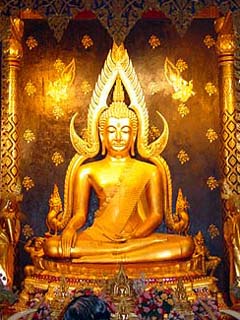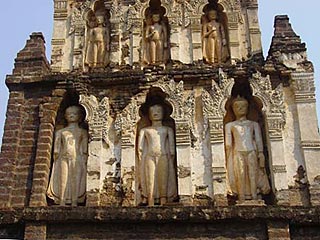| The Buddha discovered the three characteristics of existence and the four noble truths.  The Three Characteristics of Existence : The Three Characteristics of Existence :
1) Dukkha - Often this term is translated as suffering. Dukkha tends to refer to anxieties experienced in the course of living. If you set a goal and are experiencing difficulty attaining it, this can be Dukkha. If you love someone and that person does not reciprocate, that may amount to Dukkha. If you try and control your child and that child seeks his or her own way, this could become Dukkha. Let us say, Dukkha implies a gap. There is nothing wrong with goals and gaps (Buddhism has occasionally been criticized for making people lazy or lackluster; and this is simply not true). It is when a gap cannot be managed that one experiences Dukkha. Often the metaphor for progress in Buddhism is a path. If you are not able to attain your goal step by step you may become frustrated. Again, the gap is not the problem, it is how you perceive it and how you deal with it that matters most. 2) Anicca - This is impermanence. All things are subject to the forces of nature. Even the rock is gradually worn down by the incessant rain drops. Intellectually, at least, this principle is not that hard to understand. 3) Anatta - This is one of the most challenging concepts in the Buddhist teachings. Anatta is often translated as no-self or not-self. This idea relates to the non-substantiality of self or personality. In other words, the self or soul that we may believe is ours does not really exist. There is nothing to cling to. In the West, we often hear people proclaim that they are seeking to find their 'real self' - for Buddhists there is no such thing. According to Buddhism, we are very lucky to have been born in a form that tends to maintain its shape as we move from task to task. Our compounded form comes into contact with nature and must fight disease, discomfort, and changing conditions. Since there is no essence, no constant state of being, we are subject to many different (impermanent) conditions. Furthermore, how we perceive ourselves may not be the way that others perceive us. We must meet others and the changing conditions around us with a flexibility (grounded in the spirit of ethics). If we do not adjust our self when conditions change, Dukkha will most likely follow. Thai people use the terms dukkha ( thuk ) and anicca ( anichang ) often in daily speech. They tend to be relatively open to change and accepting loss, but this does not mean that they simply accept fate blindly. Understanding fate and the momentum of karma is different from being fatalistic. The Four Noble Truths : 1. The existence of suffering (Dukkha)
2. The reality that suffering is impermanent and will eventually end
3. The reality that suffering is a consequence of desire : the desire to possess what seems pleasurable and to avoid what seems unpleasurable.
4. Suffering can be brought to an end through practising of the Dhamma The dhamma, or 'Buddhist life', encourages the Eightfold Path, to put an end or control the existence of Dukkha (suffering) : 1. proper understanding
2. proper thought
3. proper speech
4. proper action
5. proper livelihood
6. proper effort
7. proper mindfulness
8. proper concentration A synonym for the Buddhist teachings is The Middle Path. Aside from this, most Thai Buddhists people in the fundamental principle of reincarnation : we can be back and do it right then. The concept of reincarnation has profound implications for Thai society. Bad circumstances (poverty, physical handicaps etc) are related to bad behaviour in a previous life. The concept of 'do good, and you will get good', 'do bad, and you will get bad (if not now, then in a later life)'. Thais also very much believe in the concept of 'making merit'. There are many ways of doing so, one common way being collecting money for donations to temples etc. A belief is that making merit, will make you more effective in coping with the existence of suffering (in the next life). As good Buddhists, the Thai perceive that all living beings stand in a hierarchy of varying ability to make actions effective and of varying degrees of freedom from suffering. Making merits, according to this view, will get you higher in the hierarchy. |  The vast majority of the Thai populations adheres to Theravada Buddhism. The Thais count their years in the Buddhist Era. At present we are in the year 2549. The Buddhist calendar is 543 years ahead of the Christian calendar, and the Buddhist era started with the passing away of the Buddha. (the Buddhist era starts one year earlier in Sri Lanka and Myanmar)
The vast majority of the Thai populations adheres to Theravada Buddhism. The Thais count their years in the Buddhist Era. At present we are in the year 2549. The Buddhist calendar is 543 years ahead of the Christian calendar, and the Buddhist era started with the passing away of the Buddha. (the Buddhist era starts one year earlier in Sri Lanka and Myanmar) The Three Characteristics of Existence :
The Three Characteristics of Existence : Historical aspects :
Historical aspects :












